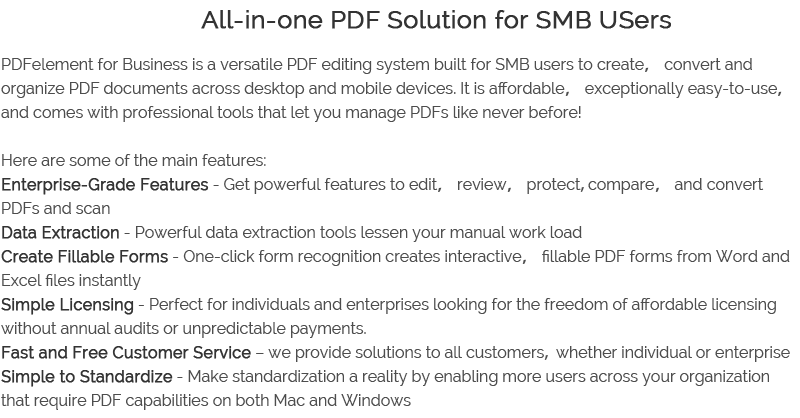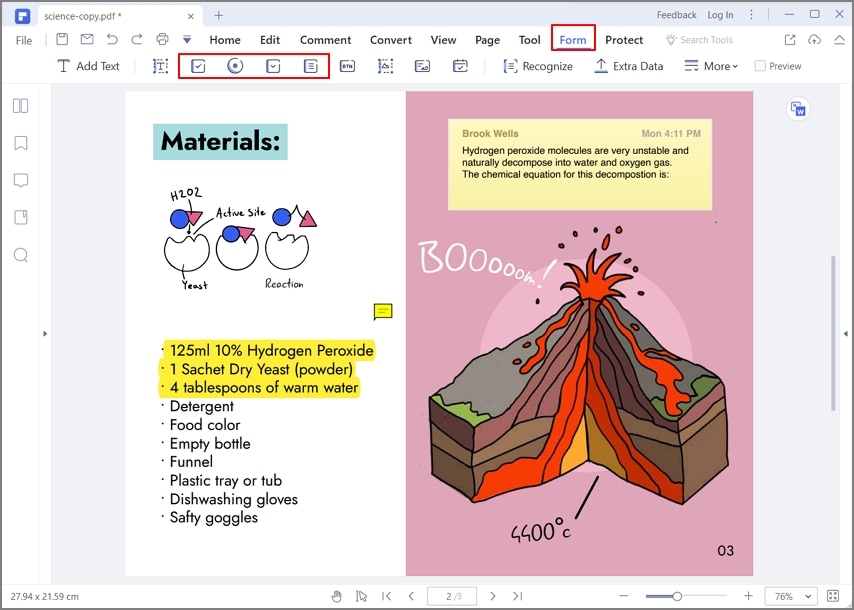How to Manage Paperless Contract File for Business - Updated
2024-04-18 14:00:40 • Filed to: Software for Business • Proven solutions
We live in an era where digital technology is growing and evolving rapidly with every passing day. Digital technology has become widely accessible for everyone, making it integral part of our lives. Some 10 years ago, it was unimaginable to have a paperless office. Nowadays, it becomes reality and more and more the standard for business. Paperless contract file is efficient, profitable and easy way to manage your documents. The term paperless contract file is term used for all paper contract and related files that have been scanned and integrated into electronic contract document.
Benefits of Manage Your Paperless Contract File

There is a saying that "habits die hard" and "people do not like change". However, for business, it is getting to a point where going paperless is a must, and everyone sticking to the old copy paper is left behind. Many paper-based organizations are having problems, challenges and struggle to keep up with the digital age. And with the growing competitive marketplaces, it is essential that business improve their efficiency. Going paperless is the best and easiest way for companies to improve their efficiency.
One of the main reasons why companies go paperless is to solve their workflow problem. Digital documents allow business to maximize workflow efficiency. Here are the four main benefits of managing your paperless contract file:
As mentioned, the first and main reason for going paperless is CLM software allows for streamlined workflow.
Contract lifecycle management software will store your information in contracts and contract related data. This way, your date and information is easily searchable, and you'll need just a mere second to find anything you need. You can grant your entire company access to the information, making it even more efficient. You now need just seconds to get a proper approval, draft, negotiate and monitor contracts. Anyone can do it, at any time. In the end, you save time, and we know in today's world time equals money.
The next reason why you need paperless contracts is to increase your data security.
Your documents are more secure, and we can easily say that the software offers bank-level security. You and you only will select who gets access to what, and who cannot get access. You allow people to edit and utilize information, and you can implement a special security program with ease.
With all the time you save, with the improved efficiency and the increased security, the main gain is that you improve your risk management.
Paperless contract file allows you to mitigate potential risks. And it is not just you that benefit from the paperless contract. Both you and the contractor benefit, as both can view the contract and identify key information.
Last, but not least, you get increased visibility.
Just by going the paperless way, you increase the transparency of your company, allowing administrators to track documents easily. All phases, starting from genesis, and up to termination are visible and recorded in your CLM. This way, you can identify any problem that might occur, identify opportunities, and plan ahead for potential risks. And of course, there is that governmental requirement of transparency.
Steps for Managing Paperless Contract Files
This is the most important part, how to get from a cluttered office, to a paperless contract file and paperless contracts. We will provide you with a seven-step guide, which will help you go from zero, to hero. Let's go.
1. Start by analyzing your current process of managing things
You must understand the current contract management process, and then you can go paperless. Some of the questions you need to ask are the following:
- How is information in your company recorded?
- Who, and how many people are involved in managing contracts?
- What is the drafting process of your company?
- How are contracts in the company actually stored?
- Can you, and how will you retrieve contracts for later usage?
- How many contracts you are losing or end up unfulfilled?
A word of notice: make sure to analyze every department separately, and then the entire company completely. Your goal here is to identify the strengths, weakness and areas of noncompliance in your company. The next step is software implementation.
2. Stat with a pilot department
If your company has several departments, it is actually hard to start the paperless contract project in all of them at once. The transition should go slow and steady, and begin with just one department. Identify one department that will serve as the guinea pig, with legal and sales usually being the best options.
Once you identify the sector you want to use as test, implement the contract management software in the sector. Make sure to involve the tech department, as they will be responsible for exploring and adapting the technology to your entire company. The better the tech department understands and explores the contract software, the easier the transition to the entire company will be.
3. The leadership team
Every project needs a leader, and your company needs a leadership team that will implement the software. You can obtain the leadership team from the higher-ups, all of which will be responsible to set the direction of the project. Once you have a goal and direction set, establish a leadership team for the implementation of the software.
Some of the people you want to include in the team include C-level administrators, internal experts and representative stakeholders. All of them can provide feedback on a regular basis, and you need that feedback to improve the project as you go on in the process of implementing paperless contract management system. Every department should have a representative, and a voice in the proceeding.
One thing to note: make sure you select people that are high in the overall hierarchy, as their voice carries more weight and they can push the agenda across the company.
4. Implement the CLM software
We are now at the main step, where you implement the CLM software across the entire company, or universally. With the right leadership team, you can get to this step rather quickly. IT administrators must be on board, as their job is to train all the employees in the company how to use the software. And if anyone has a question, it is up to the IT sector to answer it.
The best way to implement the software is by running sample contract to demonstrate the process to all employees. As Benjamin Franklin puts it "Tell me and I forget, teach me and I may remember, involve me and I learn". So, involve all the employees in the process, and they'll learn how to properly use the software.
5. Increase awareness
Once you implement the software on a global base in the company, the next step is to make sure that every employee understands the implementation, and how to use the software. And this is a regular task, not one that you can finish by asking employees "Do you understand"?
The purpose here is to raise awareness and increase compliance with the company and the procurement protocol. The trick is that not all departments use the same language. For example, engineering and legal do not use the same language. The legal department knows how to mitigate risk, avoid lawsuits and increase clarity in the contracts. The engineering department does not. After all, their job is not contracts. Therefore, you need to make sure that engineering is not leaving the company open to possible litigation. The goal here is to raise the awareness, and make sure that every department uses the same standard contract language. This way, the risk to ambiguous contracts is smaller.
Also, it is worth noting that every department should store the contracts in the same location, which in essence will reduce the risk for lost contracts.
6. Measure the impact
As with every new project, once you implement it, the next step is to measure the impact. You need to establish a system of useful metrics to determine whether going paperless was a good move, or not. Pay attention to see how the efficiency of the company goes up or down.
7. Evolve and adapt
One of the biggest mistakes is that once you install the paperless contract file system, your job is done. Not by a landslide. Going paperless requires constant evolving and adapting to the process.
Yes, you can always find a system that will last for 10 years. But it is much better to find one that will evolve with your company, one that is scalable and adaptable. Your goal in the last step is to document all the good and the bad aspects of the paperless office, note the methodology, and then record how your company adapted to the software. That will be helpful to next generation, and even to your own company.


Free Download or Buy PDFelement right now!
Free Download or Buy PDFelement right now!
Buy PDFelement right now!
Buy PDFelement right now!
Up to 18% OFF: Choose the right plan for you and your team.
PDFelement for Individuals
Edit, print, convert, eSign, and protect PDFs on Windows PC or Mac.
PDFelement for Team
Give you the flexibility to provision, track and manage licensing across groups and teams.



Elise Williams
chief Editor
Generally rated4.5(105participated)